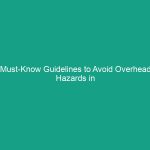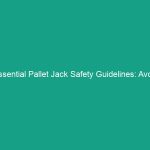Introduction
Good morning team! Today, we’re going to talk about something that is crucial to our Safety on the job – Essential Overhead Power Lines Safety Guidelines: Avoid Critical Risks. Understanding the risks associated with overhead power lines is vital for anyone working in or around construction sites, outdoor work areas, or Maintenance operations. This topic is not only important for your Safety but also for the safety of your coworkers and the public.
Understanding Essential Overhead Power Lines Safety Guidelines
Overhead power lines are electrical wires that are suspended in the air to deliver electricity from one location to another. While these lines are essential for our daily operations, they pose significant Hazards if proper safety guidelines are not observed. Many employees may underestimate the risks involved, thinking that accidents are unlikely. However, the reality is that contact with overhead power lines can lead to severe injuries or even fatalities.
Key Hazards, Risks, and Safety Considerations
Some of the specific hazards associated with overhead power lines include:
- Electrocution: Coming into contact with a live power line can result in serious injury or death.
- Falling Objects: Equipment or tools that come into contact with power lines can fall, posing risks to those below.
- Fire Hazards: Electrical shorts can ignite Fires, especially in dry conditions.
- Inadequate Training: Lack of knowledge about Safe Practices increases the likelihood of accidents.
Ignoring safety protocols can lead to devastating consequences, including loss of life, severe injuries, and extensive property damage. It’s crucial that we recognize these dangers and take proactive steps to mitigate them.
Best Practices, Procedures, & Actionable Advice
Now, let’s discuss some Best Practices to ensure our safety when working near overhead power lines:
1. Maintain Safe Distances
Always be aware of the minimum safe distance from overhead power lines. The National Electrical Safety Code recommends:
- 10 feet for voltages up to 50,000 volts.
- For voltages above 50,000 volts, increase the distance by 4 inches for every additional 10,000 volts.
2. Use Proper Equipment
When working near power lines, ensure you use tools and equipment that are rated for electrical safety. Always inspect your tools for any signs of damage before use.
3. Implement a Safety Plan
Create and follow a safety plan that includes:
- Identifying the location of overhead power lines at your job site.
- Establishing a clear communication plan with your team.
- Training employees on how to handle emergencies related to power lines.
4. Use Spotters
When operating large equipment near power lines, utilize spotters to help guide operations and maintain safe distances.
5. Report Hazards
If you notice any hazards related to overhead power lines, report them immediately to your supervisor. It’s everyone’s responsibility to maintain a safe work Environment.
Regulations, Standards, and Compliance
It’s essential to be aware of the Regulations and Standards that govern overhead power line safety. The Occupational Safety and Health Administration (OSHA) sets forth guidelines that must be followed, including:
- osha standard 1926.1408, which addresses the proximity of equipment to power lines.
- ANSI standards that provide additional guidelines for working near Electrical Hazards.
Compliance with these standards is not just a legal requirement; it protects you and your coworkers from unnecessary risks. Understanding these regulations will empower you to work safely and effectively.
Employee Engagement & Discussion
Let’s open the floor for discussion. What safety challenges have you encountered related to overhead power lines? Have you seen any near-miss incidents that we could learn from? Sharing your experiences can help us all improve our safety practices.
Conclusion & Key Takeaways
To wrap up, let’s summarize the key points we discussed today:
- Maintain a safe distance from overhead power lines.
- Use appropriate tools and equipment.
- Develop and follow a comprehensive safety plan.
- Involve spotters when operating near power lines.
- Report any safety hazards immediately.
By applying these essential overhead power lines safety guidelines, we can avoid critical risks and create a safer work environment for everyone. Thank you for your commitment to safety and for your attention today. Let’s prioritize safety in everything we do!


